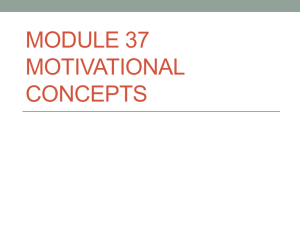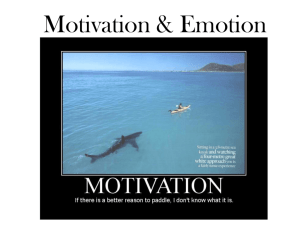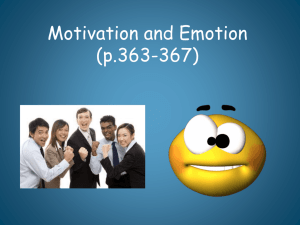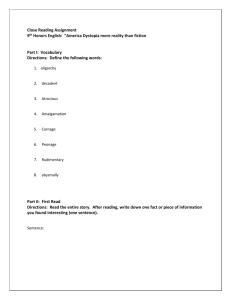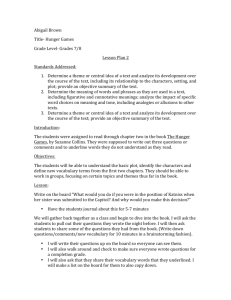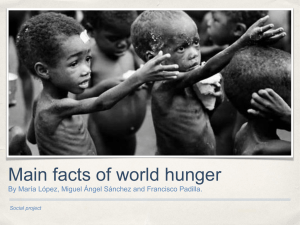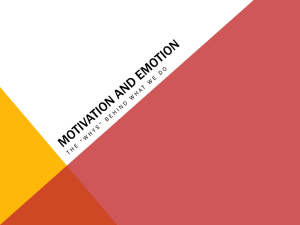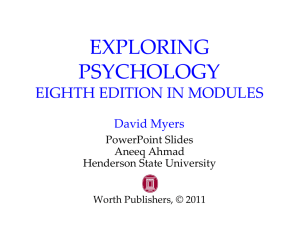File
advertisement
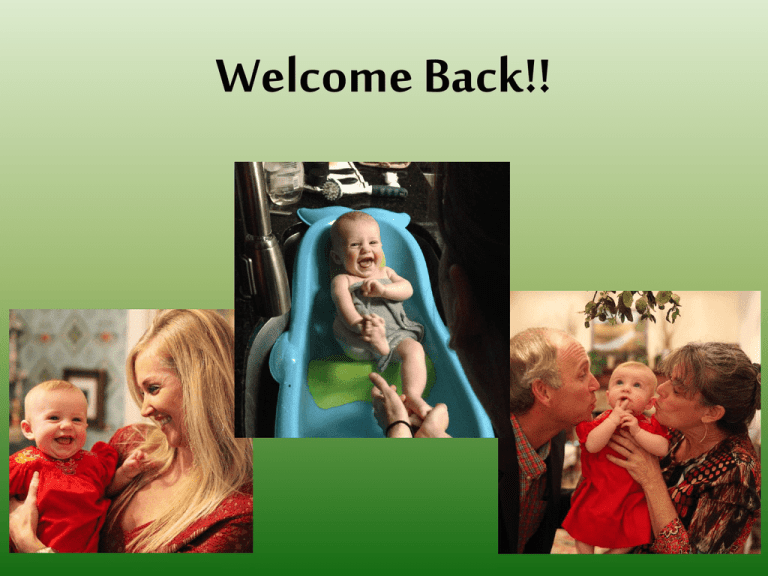
Welcome Back!! 1 Unit 8 Dates • Quiz – Friday 1/8 Over modules 37, 38, 40 41 • Summaries – Due 1/13 (Wed) • Test – 1/14 - Thursday 2 MOTIVATION 3 • https://www.youtube.com/watch?v=eODV WZhYGeI 4 Aron Ralston • Why would he do this? • What were his motivations? – Thirst and hunger – Will to live – Relationships with others 5 Motivation • A need or desire that energizes behavior and directs it towards a goal. 6 Four Perspectives on Motivation 1. 2. 3. 4. Instinct Theory Drive-Reduction Theory Arousal Theory Hierarchy of Needs 7 1. Instincts • Sometimes we can’t help our behavior • Instincts – a complex behavior that is rigidly patterned throughout a species and is unlearned • Infants have the rooting and sucking reflex • Birds imprint 8 9 2. Drive-Reduction Theory Main idea: A physiological need *creates an aroused tension state (a drive) *that motivates an organism to satisfy the need. 10 Drive Reduction • Homeostasis -The maintenance of a steady internal state • Controlling body temperature • When you get cold…what does she do? • Complain 11 Incentives • A positive or negative environmental stimulus that motivates behavior • Push or pull us to reduce our drives A food-deprived person who smells baking bread (incentive) feels a strong hunger drive. 12 Why did…. • • • • • Beethoven write a symphony? Da Vinci paint the Mona Lisa? A hiker climb Everest? A scientist find a polio vaccine? Neil Armstrong want to go to the moon? • Can you categorize these as instincts or drivereducing behaviors? • What are they? 13 3. Optimum Arousal Theory • We are curious people! We want to be aroused! • We seek optimum levels of arousal • Young monkeys and children are known to explore the environment in the absence of a need-based drive. Randy Faris/ Corbis Harlow Primate Laboratory, University of Wisconsin 14 Yerkes-Dodson Law • How “aroused” should we be? • Moderate arousal leads to optimal performance • Difficult tasks? • Easy tasks? 15 If you were on a deserted island, what would you look for… • • • • The first day? The first week? The first month? The first year? 16 4. Hierarchy of Needs • Abraham Maslow (1970) suggested that certain needs have priority over others. • Physiological needs like breathing, thirst, and hunger come before… • Psychological needs such as achievement, self-esteem, and the need for recognition. (1908-1970) 17 Hierarchy of Needs Joe Skipper/ Reuters/ Corbis Mario Tama/ Getty Images David Portnoy/ Getty Images for Stern Menahem Kahana/ AFP/ Getty Images Hurricane Survivors 18 Does hunger really affect our lives greatly? 19 Summary 20 The Physiology of Hunger Stomach contractions (pangs) send signals to the brain making us aware of our hunger. 21 Glucose: C6H12O6 • Our body automatically regulates our caloric intake • Glucose – sugar in the blood that provides energy • When it is low, we feel hungry • Do you remember what part of the brain receives messages about hunger? – Hypothalamus 22 Hypothalamic Centers • Lateral hypothalamus brings on hunger • When stimulated, rats began to eat • Ventromedial hypothalamus depresses hunger • When stimulated, rats stopped eating • What do you think happened to this fellow? 23 Do we have a set weight? • Set point – the point at which an individual’s “weight thermostat” is supposedly set • When the body falls below this weight, an increase in hunger and a lower metabolic rate may act to restore lost weight • Basal Metabolic Rate – the body’s resting rate of energy expenditure 24 Do different cultures like to eat different things? • Like what? • How do Americans feel about dog, rat, and horse meat? • Why do we like sweet and salty things? – Evolutionary 25 Body Image (Women) Western culture tends to place more emphasis on a thin body image in comparison to other cultures. 26 Obesity • A disorder characterized by being excessively overweight. • Obesity increases the risk for health issues like cardiovascular diseases, diabetes, hypertension, arthritis, and back problems. http://www.cyberdiet.com 27 Obesity Epidemic • http://www.hsph.harvard.edu/nutritionsourc e/an-epidemic-of-obesity/ 28 Summary 29 Food Inc • https://www.youtube.com/watch?v=2Oq24h ITFTY 30 The Need to Belong https://www.youtube.com/watch?v=3gNrkgwS6aM 20th Century Fox/ Dreamworks/ The Kobal Collection “Cast Away,” Tom Hanks, suffers from social starvation. 31 Belongingness 1. 2. 3. 4. 5. 6. Aiding Survival: Social bonds increased survival rates among ancestors Wanting to Belong: The need to belong colors our thinking and emotions. Social Acceptance: A sense of belonging with others increases our self-esteem. Social segregation decreases it. Maintaining Relationships: We resist breaking social bonds, even bad ones. Ostracism: Social exclusion leads to demoralization, depression, and at times nasty behavior. Fortifying Health: People who tend to have close friends are happier and healthier 32
